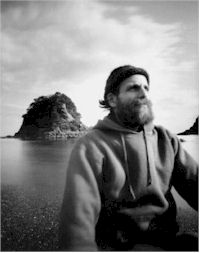Seeing the Sea

I am at my home in the mountains three kilometers inland and can hear the sea. The clouds flowing across the sky direct my thoughts toward the coast. Eyeing the light, I hop in the always-equipment loaded car, and head for one of my favorite points.
Down at the beach watching the flow of the waves, the rhythmic movements stir up images. How many times have I been here? How familiar, yet how new and fresh. How to capture the feeling of the moment, the light of the season, the breath of the wind. Thoughts go through my mind as I "prepare" to make pinhole photos of the sea.
I say go through the mind but it is partly unconscious. It is a feeling or intuition, combined with memories of inner landscapes. The desire to share the experience with others encourages me to get out the camera.
And why the pinhole camera instead of another device? I don't really see this world in fractions of a second as modern cameras do. Taking in a scene with all the senses, with the heart and mind, for 15 seconds, a minute, or an hour is for me a contemplation of life itself. When I view the ocean in all its vastness, it is recorded in my memory.
As a tool, the pinhole camera helps me to express what I feel in those intimate moments in nature. The eye is the aperture; the image is imprinted on my light sensitive inner being. "Satori" enlightenment may come in an instant, but it is the culmination of something accrued over time.
The pinhole camera becomes the witness to my ongoing journey. Together we observe, preserve, and take the scene home with us.

The coastline where I live has an ancient quality about it. Though high-rises can be found, sticking out like some kind of testament to mankind's hormones, they are no matches for the clumps of rocks that were cast into the sea eons ago. I climb carefully over the slippery rocks, eyeing the crevices kissed by the ebb and flow of the waves.
I find a vantage point that is safe yet close enough to the edge to keep me excited. The intuitive mind goes to work. How do the clouds of this day balance with the size of the waves? Is it bright and magnificent or gray and moody? Is it a midday 10-second exposure or the evening glow at three minutes? What is it that drew me into this scene? What keeps me here in freezing cold wind with the smell of damp seaweed under foot? Is it nostalgia or a sense of duty?
I go to work with a beat up old tripod and hearty plywood box cameras amidst the salt air. I level the horizon by siting with the top edge of the camera. It is interesting to note that without a viewfinder and setting up the camera as my eye sees the scene, the horizon gets placed in the middle of the picture. Contrary to photography composition rules, it is natural for the horizon to be in the center of the frame. And with pinhole photography it seems to take more of a concentrated effort to get the horizon to be off centered.
One of my personally favorite seascape images is called Balancing, precisely because the horizon is directly in the center. The image titled Rocky Coast was taken from a slightly higher vantage point so the composition is more traditional. Practically and aesthetically speaking, in Balancing the sky and sea were of "equal" beauty. In Rocky Coast, the gray sky attracted less attention.
A tip Iearnt from a large format "lens" photographer who works with long exposures is to watch the flow of the waves and open and close the shutter during the exposure. I try to imagine how I want the flow of the waves and the interplay of the rocks to look on film. I use this technique often and feel it works well with pinhole. Not only am I painting with light, but with water. It involves me in the scene, and gives me more control over the photographic result.
When using a wide-angle pinhole camera, as many people do, I get real close to the water. On sandy beaches, I am usually right on the edge and inevitably get wet feet. Losing a few shots to camera shake from soft sand and moving water rushing about the tripod legs is part of the game. Longer focal lengths keep the feet dry and make a tighter image but the bigger boxes or extended bellows get pretty shaky in strong sea winds. I admit there are days I shoot 6 or 8 sheets of film, have a great time, come home, develop the film, and none of the images turn out the way I imagined. They are boring or don't capture the magic of the moment. It wasn't necessarily the technique that was wrong, but rather that the random elements didn't all come together in a harmonious way. It may be that the outer elements weren't right from the start but my desire to be at the beach and practice my "art" was. It is my experience this can also happen with a lens camera.
For me the "decisive" image is born when the inner elements and the outer environment join together as one. As photographic writer Estelle Jussim's titled one of her books, it is "The Eternal Moment".

